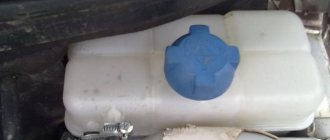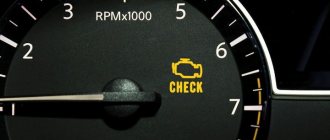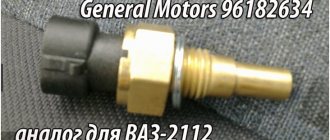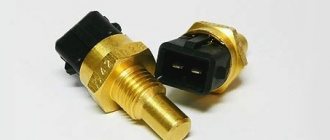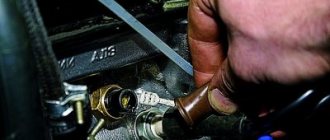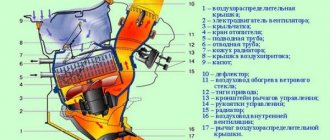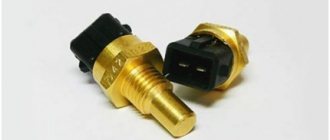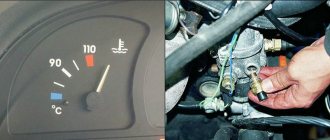03/02/2022 3 183 Cooling system
Author: Victor
The cooling system is one of the important components in any car. Vehicles today are equipped with a variety of regulators and measuring instruments designed to ensure the correct operation of the internal combustion engine. We will describe below where the coolant temperature sensor is located, why it is used and how to change it.
[Hide]
Purpose of the device
DTOZH should not be confused with an antifreeze level controller. If the first is intended to detect the temperature of the power unit, then the second is used to control the volume of consumables - refrigerant. Based on the DTOZH readings, the control unit detects temperature changes and transmits data to the on-board computer about the state in which the engine is operating. Using the controller, engine warm-up, overheating, and the optimal temperature of the operating internal combustion engine are determined. Pulses transmitted to the control module determine the functionality of the internal combustion engine control system as a whole.
The engine temperature determines the following nuances:
- fuel consumption per 100 km;
- volume and quality of gases;
- ignition of the air-fuel mixture;
- optimal operation of the gearbox.
All these factors are controlled by a control device, which, based on the information received, determines the optimal operating mode of the engine. Therefore, the performance of the temperature sensor is important for the vehicle. If the device is faulty and sends incorrect pulses to the control module, this can lead to problems.
How does DTOZh affect the operation of the internal combustion engine?
Based on the parameters supplied to the control device, the module performs the following functions:
- Enrichment of the air-fuel mixture or its depletion. If the controller detects that the temperature is too low, it will begin to increase the duration of the signal sent to the injectors, which helps to enrich the fuel mixture. In accordance with the normalization of the temperature regime, the fuel is gradually depleted, which prevents possible excessive consumption of gasoline and reduces the volume of exhaust gases. If the sensor breaks down, it can regularly lower the temperature in the engine, which will lead to fuel contamination and increased consumption.
- The control unit sets the ignition. It can be early or late. If the temperature increases, the control module adjusts the ignition timing to reduce exhaust toxicity.
- Thanks to DTOZH, proper recirculation of gases is performed during warming up. The recirculation valve closes tightly when the power unit warms up. If the car’s engine is still cold, then recirculation will cause fluctuations in idle speed and random engine stops.
- With the help of DTOZH, the control unit purges the filtration system, which traps fuel vapors. To achieve better machine controllability, the carbon filter element is not purged until the engine is completely warmed up.
- Locking of the gearbox torque converter when the internal combustion engine warms up. The control module should not limit the operation of the device until the machine warms up.
- The ECU controls the operation of the unit's cooling fan. Based on the temperature controller readings, the module activates and deactivates the ventilation device to correctly select the temperature of the unit. If the DTOZ gives incorrect impulses, there is a possibility of the motor overheating.
Principle of operation
The operation of the device is carried out by changing the electrical resistance of the material used in the sensitive element located inside depending on the temperature. The device consists of a sensitive cone and a pair of electrically conductive contacts that allow it to communicate with the computer through a connection to an electronic circuit.
Verification measurements of the device influence not only the stabilization of the engine temperature, but also a number of other elements of the system:
- increase in engine speed when warming up. This stabilizes the transition of the motor to operating mode;
- adjusting the opening and closing of the exhaust recirculation valve;
- calibration of ignition timing.
Overview of types of DTOZH: design and principle of operation
Let's take a closer look at the operating principle and types of controllers.
Magnetic
Such controllers consist of coils located on the sides of a steel armature. The arrow of the controller located on the instrument panel in the cabin is connected to the latter. The first coil is connected to the vehicle's on-board network, and the second to a cable with varying resistance. This parameter changes according to the temperature values in the engine. The voltage passing through the coils creates a magnetic field that controls the armature. The element displacement parameter is determined by the field difference depending on the current value.
User Irimiya Evgeniy showed in his video how unstable the DTOZh is.
Bimetallic
The operating principle of bimetallic controllers is based on the expansion of elements during heating. The device is equipped with a rod that changes size as the temperature of the internal combustion engine increases. The stripes in the coil rotate the arrow on the control panel in the car's interior in accordance with the current value.
Modern antifreeze temperature sensors can use two types of sensors:
- semiconductor;
- bimetallic.
The latter are practically not used today. The strip in such controllers moves to the coil and opens the contacts, helping to change the amount of current flowing to the dashboard. And semiconductors are used everywhere. The control unit supplies a signal to the device thermistor with a negative coefficient through a resistive element with constant resistance. As the temperature increases, the resistance in this circuit drops. Accordingly, the voltage level decreases. The control module detects a decrease in this parameter and determines the temperature of the consumable material, displaying it on the control panel with an indicator.
Capillary
It is considered the oldest and irrelevant type of sensor for use today. The arrow on the device is directly connected to the device. The controller is made in a housing in the form of a container with consumables, which has a low boiling point. The reservoir is connected to a pointer as well as a steel tube. When the power unit warms up, the refrigerant in the container begins to boil and evaporate, resulting in an increase in pressure in the flask. This parameter is sent to the pointer where the Bourdon tube is located. This element begins to straighten as a result of pressure and moves the arrow on the control panel.
This type of controller is almost never used for several reasons:
- the measuring element itself runs through the entire engine compartment, connecting to the tube on one side and to the control panel on the other;
- The capillary tube is quite thin and is quickly damaged during operation.
Photo gallery “Varieties of DTOZH”
Diagrams of different types of sensors are shown in the photo.
Magnetic type DTOZH
Bimetallic sensor
Capillary sensor circuit
What are the causes of DTOZh malfunctions?
Replacing the coolant temperature sensor is considered the last step in repairing the problem. Since most often, difficulties with the sensor are not at all related to its specific malfunction, simply for the reason that there is practically nothing to break in it.
The main malfunctions include:
- low quality coolant. As a result of using low-quality products, the surface of the device may be corroded and covered with sediment. As a result, the detector begins to give incorrect readings, most often downward. As a result, untimely start of the cooling system leads to boiling of the engine;
- poor quality device. A low-quality device includes not only defects in the factory assembly itself, but also the absence of a sealed gasket, or excessive force when screwing in the device, leading to its failure or breakage;
- Leak/lack of antifreeze. As a result of poor sealing of the device, wear of the seal, or cracks in the thermostat, leaks may occur. Also, a lack of coolant can be caused simply by untimely replenishment of the tank. The result, one way or another, is the lack of contact between the device and the liquid, and as a consequence the lack of measurements.
- Disruption in the electrical network. Electronics failure is considered one of the most common defects. Problems on the line, short circuits, oxidation of contacts. All this leads to malfunction of the device. Problems in the ECU itself can also be attributed to this point. They lead to failures in control of the measuring device.
Where is the sensor located?
Before checking and changing the device, you need to know about its location. Where the sensors are installed depends on the car manufacturer.
The device location can be like this:
- in the cylinder head;
- on the upper line of the radiator device;
- in the thermostat housing.
Regardless of where the controller is installed, the device is fixed next to the outlet hose through which the coolant enters the radiator. This is important because it is this mounting location that allows you to accurately determine the temperature of the consumable.
The design of the cooling system on the VAZ-2114
Coolant temperature sensor location
Before proceeding directly to the replacement process, it is necessary to understand the design of the cooling system and the location of the sensor in the main power unit:
Everything here is trivial
1 – element in the form of a plug for the expansion tank; 2 – expansion tank; 3 – hose for draining liquid from the pipe; 4 – hose passing between the radiator and the expansion tank; 5 – hose leading from the radiator; 6 – tank to the left of the radiator; 7 – aluminum tube; 8 – plug systems; 9 – tank to the right of the radiator; 10 – drain plug; 11 – middle of the radiator; 12 – casing for electric fan; 13 – plastic wings of the electric fan; 14 – electric motor; 15 – toothed pump pulley; 16 – pump impeller; 17 – camshaft drive belt; 18 – engine block; 19 – pump pipe; 20 – radiator hose with supply function; 21 – heater radiator hose with drain function; 22 – hose supplying coolant to the throttle pipe; 23 – exhaust pipe; 24 – hose for refilling; 25 – heater radiator hose with supply function; 26 – thermostat; 27 – coolant temperature sensor; 28 – coolant level indicator sensor.
The process of replacing the sensor (DTOZH)
As mentioned earlier, the replacement process is too simple and will only take 10-15 minutes.
Therefore, as practice shows, motorists carry out the operation with their own hands. So, let's look at the sequence of actions aimed at replacing the coolant sensor:
- Remove the terminal from the battery.
We dismantle the battery terminal
- Unscrew and remove the air filter. This is necessary in order to ensure maximum access to the sensor.
In order to get to the sensor you need to remove the air filter
- Disconnect the wires that power the element.
Disconnect the sensor power supply connectorCoolant temperature sensor with removed chip
- Using a 19 key, we dismantle the product.
Dismantling of DTOZHUsing a 19mm wrench, unscrew the sensor.
- Assembly proceeds in reverse order.
Product selection
The choice of product should be approached carefully, since its quality will directly depend on its service life, as well as engine operating modes. So, let's consider all the options for purchasing a coolant temperature sensor for the VAZ-2114.
Original
Original view of the coolant sensor produced by AvtoVAZ
2101-3808600 – original catalog number of the part, which is installed on almost all cars of the Lada family. This product is produced at the AvtoVAZ plant. The cost is 300 rubles. Installed in a standard mounting location and does not require modifications.
Analogs
In addition to the original part, there are a number of analogues that can be installed on a car. Some of them are much better quality than the original.
It was not the original sensor
So, let's consider all the analogue options for the coolant temperature sensor:
| Manufacturer's name | Catalog number | Cost, in rubles |
| Fenox | TSN22101 | 210 |
| LUZAR | LS 0101 | 240 |
| Fenox | TSN22101O7 | 240 |
| Vernet | 2509 | 250 |
| Patron | PE13059 | 300 |
| Intermotor | 52400 | 300 |
| Era | 330082 | 350 |
| Facet | 7.3000 | 350 |
| Eps | 1.830.000 | 400 |
| KW | 530.000 | 550 |
| H+B Elparts | 70511515 | 600 |
| Cargo | 180804 | 700 |
| Hella | 6PT 009 107-151 | 750 |
Coolant sensor made by Hella
Consequences of untimely sensor replacement
Not many car enthusiasts know that a malfunction of the coolant temperature sensor affects the operation of the engine as a whole. Let's consider the main consequences of a malfunction of this unit for a car:
- Incorrect operation of the electronic engine control unit . Thus, the sensor does not provide reliable data to the ECU, which in hot weather may not turn on the cooling fan in time. So, in turn, the consequence will be that the car will boil. This can lead to the fact that in the worst case, it can cause deformation and sagging of the head.
- Due to incorrect operation of the sensor, the following functions may be impaired: engine performance, driving dynamics, thermostat operation .
- Other consequences to which the sensor is indirectly linked.
Symptoms of a problem
The AndRamons channel provided a video about the controller verification process.
The main symptom of a controller malfunction is the inoperability of the ventilation device when the power unit warms up. But the machine can also be equipped with a fan activation sensor that performs the switching function. Then the reason should be sought in damage to the electrical circuit or failure of the controller.
What other symptoms can be used to determine the inoperability of the DTOZH:
- increased fuel consumption;
- difficult engine start when the unit is warmed up;
- increased idle speed;
- engine detonation;
- unit overheating.
Many modern cars have an electronic fault detection system. Errors may appear on a special screen on the dashboard when the DTOZ breaks down. But usually fault codes indicate both a possible breakdown of the sensor and damage to the wiring or controller connector.
Checking the DTO on a car
Correspondence table for temperature, resistance and voltage parameters for checking DTOZH
The essence of diagnosing the controller on the car and outside the car is to check the resistance and voltage values.
Checking the second parameter is done using a voltmeter:
- Connect the probes of the device to grounding, as well as to the signal contact of the controller.
- The engine must be cold. Turn on the ignition.
- Measure the voltage parameter and compare the data obtained in accordance with the table.
To diagnose the temperature parameter you will need a thermometer:
- measure the temperature of the consumable;
- start the engine and let it warm up, while heating the internal combustion engine, measure the voltage value taking into account the temperature change;
- If the obtained parameters do not correspond to the table ones, then the device has failed.
User Yakovlev Dmitry showed in the video how to check the controller.
Using an ohmmeter, perform a resistance test:
- Diagnostics are carried out at different temperatures of the machine motor. The parameters are compared with the table ones.
- If the resistance value on a cold engine is in the correct range, then the temperature of the consumable may deviate to the side by several degrees.
Check outside the car
For diagnostics outside the car:
- Place the device in a tank of water and check the temperature.
- Measure the DTOZ resistance parameter. Check the results obtained with those indicated in the table.
- The container with water gradually heats up. During warm-up, periodically check the resistance level and temperature.
What symptoms indicate problems with the sensor?
During long-term operation of the car, obvious and indirect signs may be observed indicating problems with the temperature sensor or its electrical circuit. The first ones directly indicate the need to check the functionality of the device:
- The engine heating indicator on the dashboard stopped working;
- the cooling fan stopped turning on, although the engine water jacket had already warmed up to 100 °C;
- antifreeze leakage from under the part body;
- The fan starts at random, including when the engine is cold.
If your car exhibits the listed signs of a malfunction of the coolant temperature sensor, then feel free to proceed to diagnosing it and fixing the problem, which will be discussed below. Indirect symptoms may indicate a breakdown of the meter or other elements of the cooling system or power unit. Here are the most common ones:
- Cold starting of the engine is difficult. The car starts, but immediately stalls, you need to make several repeated attempts. The cause may be a thermocouple, throttle position sensor, insufficient compression or ignition problems.
- Unstable operation at idle. In addition to the temperature meter, it is affected by the serviceability of the spark plugs, mass flow sensor, injectors and many other factors.
- The temperature is within normal limits, but the coolant begins to boil. If the thermostat fails or the level of antifreeze in the jacket decreases, then the readings of the device may differ from the real state of affairs.
The serviceability of an electronic temperature meter can be checked at home. If indirect symptoms of a malfunction are observed, the test will help to identify them or exclude them from a number of parts that are “under suspicion.” If you successfully check the problem, you will have to look elsewhere or contact the nearest auto repair shop.
We recommend: Removing and installing the intercooler (models with a turbocharger)
Replacing the coolant temperature sensor
You can only replace a failed DTOZ with a similar device.
Required Tools
To complete the task you will need:
- container for collecting waste liquid;
- wrench 19;
- sealant.
Step-by-step instruction
Dismantling and installing the controller is performed as follows:
- Some of the coolant must be drained from the radiator; this will be required to dismantle the sensor.
- Disconnect the connected wires from the device.
- The controller itself is disabled using a 19mm wrench.
- Run device diagnostics if necessary. If you are changing the device, then before installation it is necessary to treat its threads with sealant.
- Screw the new controller into place and connect the wiring to it.
- Fill the cooling system with previously drained antifreeze. Make sure that there is no refrigerant leaking through the unit.
How to check
To independently determine the malfunction of the device, you need to check it: to do this, it is initially recommended to turn off the power to the car by removing the connectors from the battery. Next, you need to drain the coolant to the last drop.
The sensor is disconnected from the car by removing all the wires connected to it - usually this is only one connector. Then unscrew the fastening and remove the DTOZH. The terminals intended for attaching the DTOZH to the car must be connected to an ohmmeter to test the device.
To proceed directly to the test, you need to prepare a shallow container with hot water in which to place the sensor so that the leads are above the surface of the water.
Next, you need to monitor changes in resistance values on the ohmmeter. As the water cools, the resistance decreases, which indicates the serviceability of the unit - if the DTOZH is not working properly, then the readings on the ohmmeter do not change.
Find out what these sensors are responsible for: crankshaft position, parking sensors, rain, coolant level, Hall ignition.
To finally verify that the unit is faulty, it is recommended to compare the ohmmeter readings you obtained during the test with the readings in the table compiled by specialists.
How to check DTOZH: video
[/video]
Video “How to change the controller correctly”
A visual guide to replacing an antifreeze temperature sensor is described in a video filmed by user Vasily Kalugin.
Do you have any questions? Specialists and readers of the AUTODVIG website will help you ask a question
Was this article helpful?
Thank you for your opinion!
The article was useful. Please share the information with your friends.
Yes (100.00%)
No
X
Please write what is wrong and leave recommendations on the article
Cancel reply
Rate this article: ( 5 votes, average: 5.00 out of 5)
Discuss the article:
Two-color LED temperature indicator on two transistors
The blue LED indicates a lower temperature, the red LED indicates a higher temperature. A decrease in temperature entails an increase in the resistance of thermistor Th1. This increases the voltage at the base of transistor VT2, which in turn opens it. Opening VT2 turns off transistor VT1. As a result, LED HL1 lights up, but LED HL2 doesn't light up.
As the temperature rises, the thermistor resistance decreases and the voltage at the base of VT2 decreases. VT2 is closed. Current begins to flow to the base of VT1 through R2, as a result it opens. This causes the HL2 LED to light up. Since both LEDs share a common current-limiting resistor R1, and the red LED HL2 has a lower voltage drop than the blue LED HL1, the blue LED will not light. This eliminates the need for any additional transistors for the HL1 LED.
If the HL1 LED does not have a high enough voltage drop, this can be solved by connecting a diode in series with it, for example 1N4007. Potentiometer R3 sets the threshold temperature. If you cannot set the desired temperature, you may need to change the value of R3 or R4.
Checking the DTOZH
The temperature sensor is the simplest device, so the principle of checking it is also quite simple.
To check the sensor you will need a multimeter and a thermometer.
The sensor must be checked by measuring the resistance on it as a result of measuring the temperature of the liquid. DTOZH increases its resistance as the liquid temperature decreases.
In order to check it, you need to connect a multimeter set to resistance readings to the ends of the sensor and lower it into a glass of boiling water. The ohmmeter reading should match the temperature reading. That is, using the table, we look for the water temperature and what resistance the sensor should have at that temperature.
Next, we perform the same procedure with cold water and look at the ohmmeter readings. Based on the measurements, we issue a verdict on the sensor.
Below is a table of DTOZH resistance depending on the coolant temperature.
Table of sensor resistance depending on temperature.

